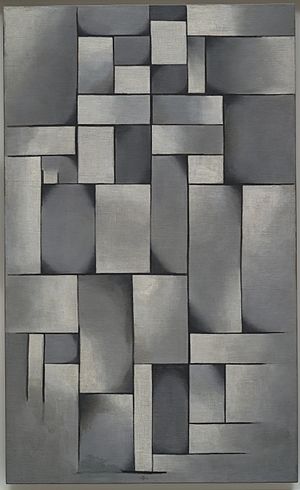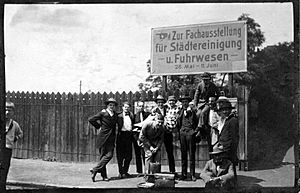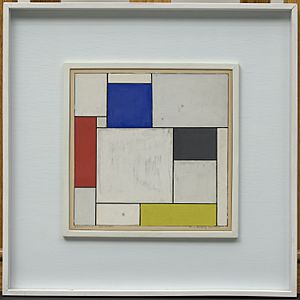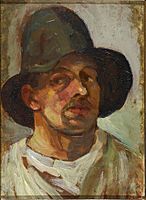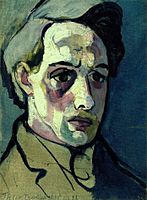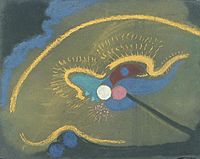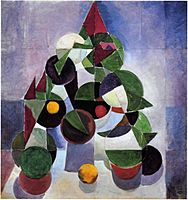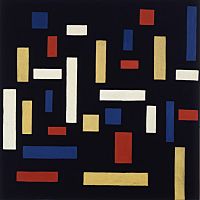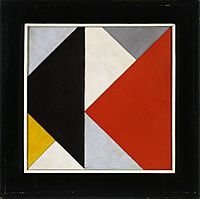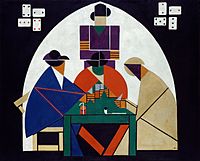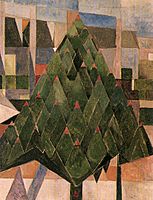Theo van Doesburg facts for kids
Quick facts for kids
Theo van Doesburg
|
|
|---|---|
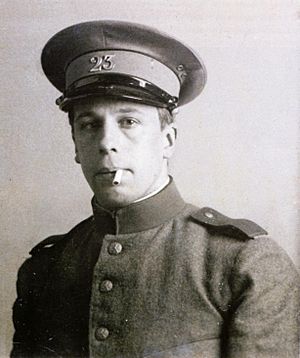
Theo van Doesburg as Sergeant Küpper, c. 1915
|
|
| Born |
Christian Emil Marie Küpper
30 August 1883 |
| Died | 7 March 1931 (aged 47) |
| Nationality | Dutch |
| Known for | painting, architecture, poetry |
| Movement | De Stijl, Elementarism, Concrete art, Dadaism |
Theo van Doesburg (born August 30, 1883 – died March 7, 1931) was a famous Dutch artist. He was a painter, writer, poet, and architect. He is best known for starting and leading the art movement called De Stijl. He was married to Nelly van Doesburg, who was also an artist, pianist, and choreographer.
Contents
Early Life
Theo van Doesburg was born as Christian Emil Marie Küpper on August 30, 1883. His birthplace was Utrecht, Netherlands. His father was a photographer named Wilhelm Küpper. Theo always thought of his stepfather, Theodorus Doesburg, as his real father. Because of this, his first artworks were signed "Theo Doesburg." Later, he added "van" to his name.
His Art Career
Theo van Doesburg had his first art show in 1908. From 1912, he also wrote for art magazines to support himself. At first, his paintings were similar to those of the Amsterdam Impressionists. He was also inspired by Vincent van Gogh.
However, his style changed a lot in 1913. He read a book by the artist Wassily Kandinsky. This book made him realize that painting could be more spiritual. He believed art should come from the mind, not just from everyday life. He felt that abstract art was the best way to show this. Abstract art uses shapes, colors, and lines instead of realistic pictures.
The De Stijl Art Movement
In 1915, while serving in the army, Van Doesburg saw paintings by Piet Mondrian. Mondrian was an older artist who was already known for his abstract work. Van Doesburg saw Mondrian's art as the perfect example of abstract painting.
Soon after, Van Doesburg and Mondrian met. They decided to work together with other artists like Bart van der Leck and Vilmos Huszár. In 1917, they started an art magazine and a movement called De Stijl. This Dutch word means "The Style."
Spreading De Stijl's Ideas
Even though many artists were part of De Stijl, Van Doesburg was its main promoter. He traveled around Europe to share the movement's ideas. In 1922, he moved to Weimar, Germany. He wanted to influence the famous Bauhaus art school there.
The head of Bauhaus, Walter Gropius, liked many modern art ideas. But he did not want Van Doesburg to become a teacher at his school. So, Van Doesburg set up his own studio near Bauhaus. He started teaching students who were interested in new art styles. These included Constructivism, Dadaism, and De Stijl.
Differences with Mondrian
Van Doesburg and Mondrian were good friends for many years. They often wrote letters to each other. In 1923, Van Doesburg moved to Paris with his future wife, Nelly van Moorsel. Being closer, they saw each other more often. This made their different personalities more obvious. Mondrian was quiet, while Van Doesburg was more outgoing.
In 1924, they had disagreements that led to a temporary split. Art historians have debated the exact reason. A common belief is that they disagreed about using diagonal lines in paintings. Mondrian preferred only horizontal and vertical lines. Van Doesburg, however, liked the energy of diagonal lines and used them in his art.
After their split, Van Doesburg started a new art idea called wikt:Elementarism. This style often used diagonal lines. It was a bit different from Mondrian's style, called Neo-Plasticism. In 1929, they met by chance in a café in Paris and became friends again.
Architecture, Design, and Writing
Besides painting and promoting De Stijl, Van Doesburg worked in other areas. He designed buildings, including houses for artists. He also helped design the decorations for the Aubette entertainment complex in Strasbourg. He worked with artists like Sophie Taeuber-Arp and Jean Arp.
Van Doesburg also helped create a new style of alphabet in 1919. This alphabet, called Architype Van Doesburg, used geometric shapes. He also worked with other artists to create children's fairy tale books. These books used unusual and fun typography.
He was also interested in Dadaism, an art movement that challenged traditional art. He published a magazine called Mécano under a pen name, I. K. Bonset. He also wrote Dada poetry using this name. He used another pen name, Aldo Camini, to write anti-philosophy texts. In his writings, he wanted to give words new meanings and power.
Later Years
Van Doesburg continued to be active in art groups. He helped start Cercle et Carré in 1929. He also co-founded Art Concret in 1929 and Abstraction-Création in 1931.
In February 1931, his health got worse. He had to move to Davos, Switzerland. Sadly, he did not recover. Theo van Doesburg died on March 7, 1931, from a heart attack. After his death, his wife Nelly van Doesburg published the last issue of the De Stijl magazine. It was a special issue to remember him.
Influence
Theo van Doesburg's work had a big impact on art, design, and architecture. For example, his artwork Space-time construction #3 (1923) was very important. It was shown in a famous exhibition called Painting toward architecture. This artwork later influenced the well-known architect Harry Seidler. In 2010, the artwork was given to the National Gallery of Australia.
Works and Publications
Publications
- Baljeu, Joost (1974). Theo van Doesburg. London: Studio Vista. ISBN: 0-289-70358-1.
- Hoek, Els; Blokhuis, Marleen; Goovaerts, Ingrid; Kamphuys, Natalie; et al. (2000). Theo van Doesburg: Oeuvre Catalogus. Utrecht: Centraal Museum. ISBN: 90-6868-255-5.
- Overy, Paul (1969). De Stijl. Studio Vista. ISBN: 0-289-79622-9.
- White, Michael (2003). De Stijl and Dutch modernism. Manchester University Press. ISBN: 0-7190-6162-8.
Artworks
-
Neo-Plasticism: Composition VII (the three graces), 1917
See also
 In Spanish: Theo van Doesburg para niños
In Spanish: Theo van Doesburg para niños


